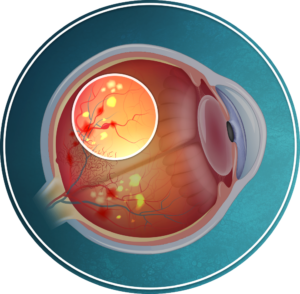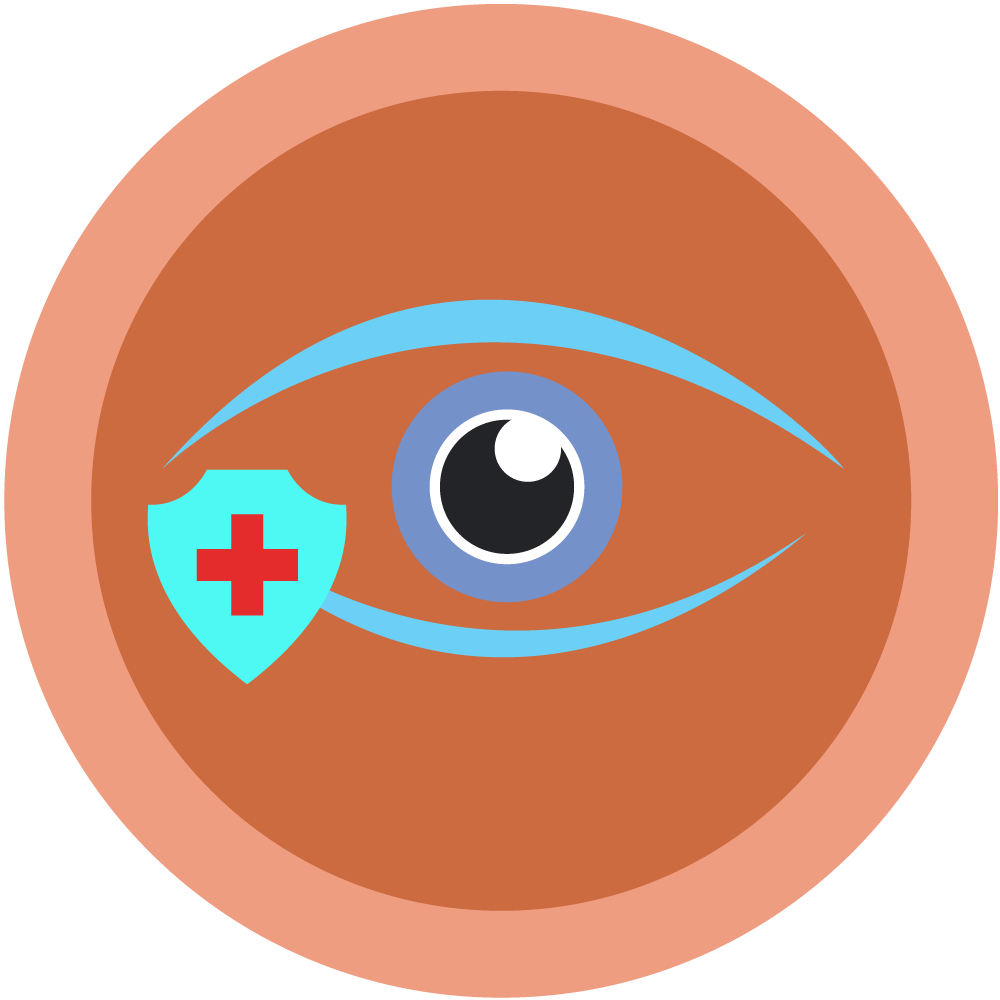This activity for Diabetic Retinopathy education is provided by Med Learning Group.
This activity is supported by an independent medical education grant from Regeneron Pharmaceuticals, Inc.
Copyright © 2019Med Learning Group. Built by Divigner. All Rights Reserved.
Consequences of DR
Symptoms of diabetic retinopathy (DR) may include:1,2
- Blurred or double vision
- Difficulty reading
- The appearance of dark spots (commonly called "floaters"), shadows, or streaks in vision
- Difficulty with vision at night (example: night driving)
- Faded color vision

It is possible to have diabetic retinopathy without any symptoms. It is also possible for symptoms appear and then resolve.6
Risk factors for development of DR
The duration of the diabetes and magnitude of elevation of blood sugar are the largest risk factors for development of DR.7-10 There is an exponential relationship between the risk of DR and mean hemoglobin A1c level (HbA1c).11 Therefore, it is recommended that HbA1c be 7% or lower for most patients.12 The most important modifiable risk factors for development of DR include blood sugar and blood pressure.13 Poor blood sugar control during pregnancy increases the risk of DR in patients with pre-existing diabetes.14
Risk Factors for progression of DR
The largest risk factor for progression of DR is poor blood sugar control.15,16 For every 10% reduction in HbA1c, there is a 39% risk reduction of retinopathy progression.17 Caution should be exercised regarding the aggressiveness of glucose control, as rapid improvement of longstanding hyperglycemia increases the risk of progression of DR in some patients. With this in mind, more frequent visits to an eye care provider are advised during this period.18
Treatment for other systemic comorbidities may also impact DR progression. Lipid lowering medications have been shown to slow the progression of DR, although the mechanism by which these agents slow the progression of DR is currently under investigation.19 Puberty, as well as pregnancy can also cause progression of DR; while changes in physiology and metabolic control are responsible in pregnancy, puberty is less clearly delineated, although hormonal changes seem to exert an effect independent of age and duration of disease.11,20
Systemic disease and DR
Damage to retinal blood vessels is part of systemic microvascular dysfunction in diabetes.21,22 Evidence of microvascular dysfunction such as diabetic nephropathy and neuropathy increases the risk of developing DR. In fact, patients with diabetic neuropathy are at 5-fold increased risk of nonproliferative diabetic retinopathy (NPDR) and 3-fold increased risk of proliferative diabetic retinopathy (PDR).23,24 In addition to the increased risk of developing DR, patients with diabetic neuropathy are also at increased risk of progression of DR.25 Regardless of the presence of systemic comorbidities, development of PDR correlates with increased risk of nephropathy, myocardial infarction, and stroke.11
References
- National Eye Institute (NIH). Diabetic Retinopathy. 2019. https://www.nei.nih.gov/learn-about-eye-health/eye-conditions-and-diseases/diabetic-retinopathy
- Gregori NZ. Diabetic retinopathy: Causes, symptoms, treatment. American Academy of Ophthalmology. 2021. https://www.aao.org/eye-health/diseases/what-is-diabetic-retinopathy
- Cleveland Clinic. Diplopia (double vision). https://my.clevelandclinic.org/health/diseases/22203-diplopia-double-vision
- St. Lukes Eye. Floaters-an overview of causes, symptoms and treatment options. https://www.stlukeseye.com/blog/floaters/
- Austin Vision Center. Are you having difficulty driving at night? https://www.austinvisioncenter.com/blog/87801-are-you-having-difficulty-driving-at-night
- Flaxel CJ, Adelman RA, Bailey ST, et al. Diabetic Retinopathy Preferred Practice Pattern®. Ophthalmology. 2020;127(1):P66-P145.
- Buehler AM, Cavalcanti AB, Berwanger O, et al. Effect of tight blood glucose control versus conventional control in patients with type 2 diabetes mellitus: a systematic review with meta-analysis of randomized controlled trials. Cardiovasc Ther. 2013;31(3):147-160.
- Do DV, Wang X, Vedula SS, et al. Blood pressure control for diabetic retinopathy. Cochrane Database Syst Rev. 2015;1:CD006127.
- Fullerton B, Jeitler K, Seitz M, et al. A. Intensive glucose control versus conventional glucose control for type 1 diabetes mellitus. Cochrane Database Syst Rev. 2014(2):CD009122.
- Virk SA, Donaghue KC, Wong TY, Craig ME. Interventions for Diabetic Retinopathy in Type 1 Diabetes: Systematic Review and Meta-Analysis. Am J Ophthalmol. 2015;160(5):1055-1064 e1054.
- Diabetes Control and Complications Trial Research Group. Diabetes Care. 2000;23(8):1084-1091.
- Ferris FL 3rd, Nathan DM. Editorial. Preventing Diabetic Retinopathy Progression. Ophthalmology. 2016;123(9): 1840-1842.
- Xie X, Atkins E, Lv J, et al. Effects of intensive blood pressure lowering on cardiovascular and renal outcomes: updated systematic review and meta-analysis. Lancet. 2016;387(10017):435-443.
- Chew EY, Mills JL, Metzger BE, et al. Metabolic control and progression of retinopathy. The Diabetes in Early Pregnancy Study. National Institute of Child Health and Human Development Diabetes in Early Pregnancy Study. Diabetes Care. 1995;18(5):631-637.
- Davis MD, Fisher MR, Gangnon RE, et al. Risk factors for high-risk proliferative diabetic retinopathy and severe visual loss: Early Treatment Diabetic Retinopathy Study report number 18. Invest Ophthalmol Vis Sci. 1998;39(2):233-252.
- Kilpatrick ES, Rigby AS, Atkin SL, Frier BM. Does severe hypoglycaemia influence microvascular complications in Type 1 diabetes? An analysis of the Diabetes Control and Complications Trial database. Diabet Med. 2012;29(9):1195-1198.
- Mohamed Q, Gillies MC, Wong TY. Management of diabetic retinopathy: A systematic review. JAMA. 2007;298(8):902-916.
- Diabetes Control and Complications Trial Research Group. Early worsening of diabetic retinopathy in the Diabetes Control and Complications Trial. Arch Ophthalmol. 1998;116(7):874-886.
- Shi R, Zhao L, Wang F, et al. Effects of lipid-lowering agents on diabetic retinopathy: A Meta-analysis and systematic review. Int J Ophthalmol. 2018;11(2):287-295.
- Lueder GT, Silverstein J. American Academy of Pediatrics Section on Ophthalmology and Section on Endocrinology. Screening for retinopathy in the pediatric patient with type 1 diabetes mellitus. Pediatrics. 2005;116(1):270-273.
- Lima VC, Cavalieri GC, Lima MC, et al. Risk factors for diabetic retinopathy: A case–control study. Int J Retin Vitr. 2016;2:21.
- Cheung N, Wong TY. Diabetic retinopathy and systemic vascular complications. Prog Retin Eye Res. 2008;27(2):161-176.
- Barr EL, Wong TY, Tapp RJ, et al. Is peripheral neuropathy associated with retinopathy and albuminuria in individuals with impaired glucose metabolism? The 1999–2000 AusDiab. Diabetes Care. 2006;29(5):1114-1116.
- Lin IC, Wang YH, Lin CL, et al. Diabetic polyneuropathy and the risk of developing diabetic retinopathy: A nationwide, population-based study. Acta Ophthalmol. 2015;93(8):713-718.
- Jeng CJ, Hsieh YT, Yang CM, et al. Diabetic Retinopathy in Patients with Diabetic Nephropathy: Development and Progression. PLoS ONE. 2016;11(8):e0161897.
All URLs accessed 4/22/22.

































